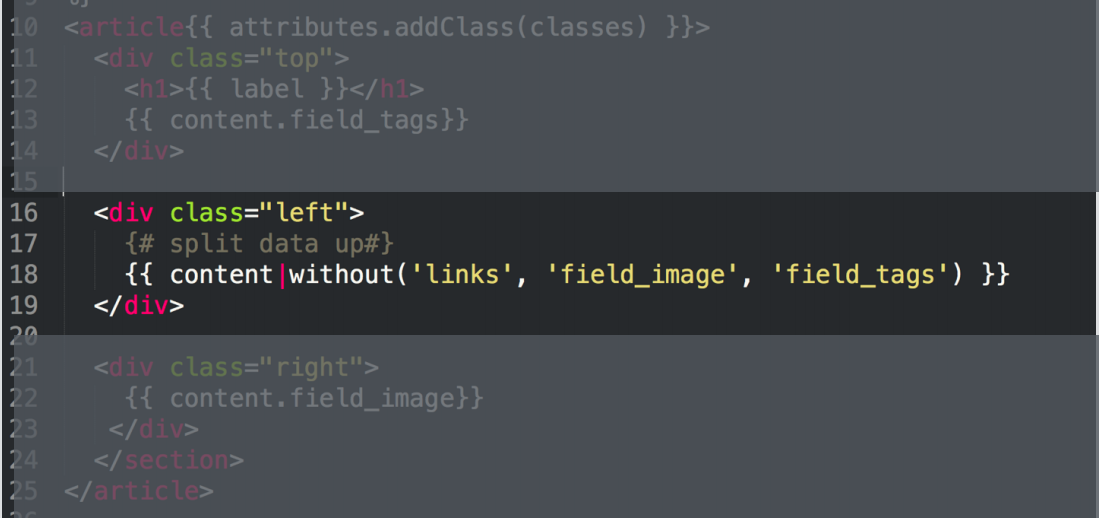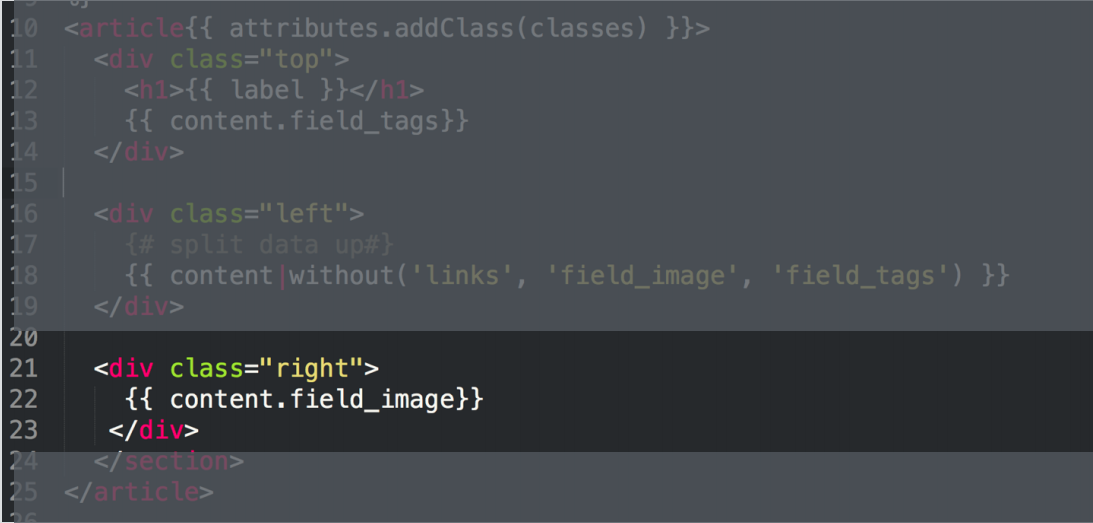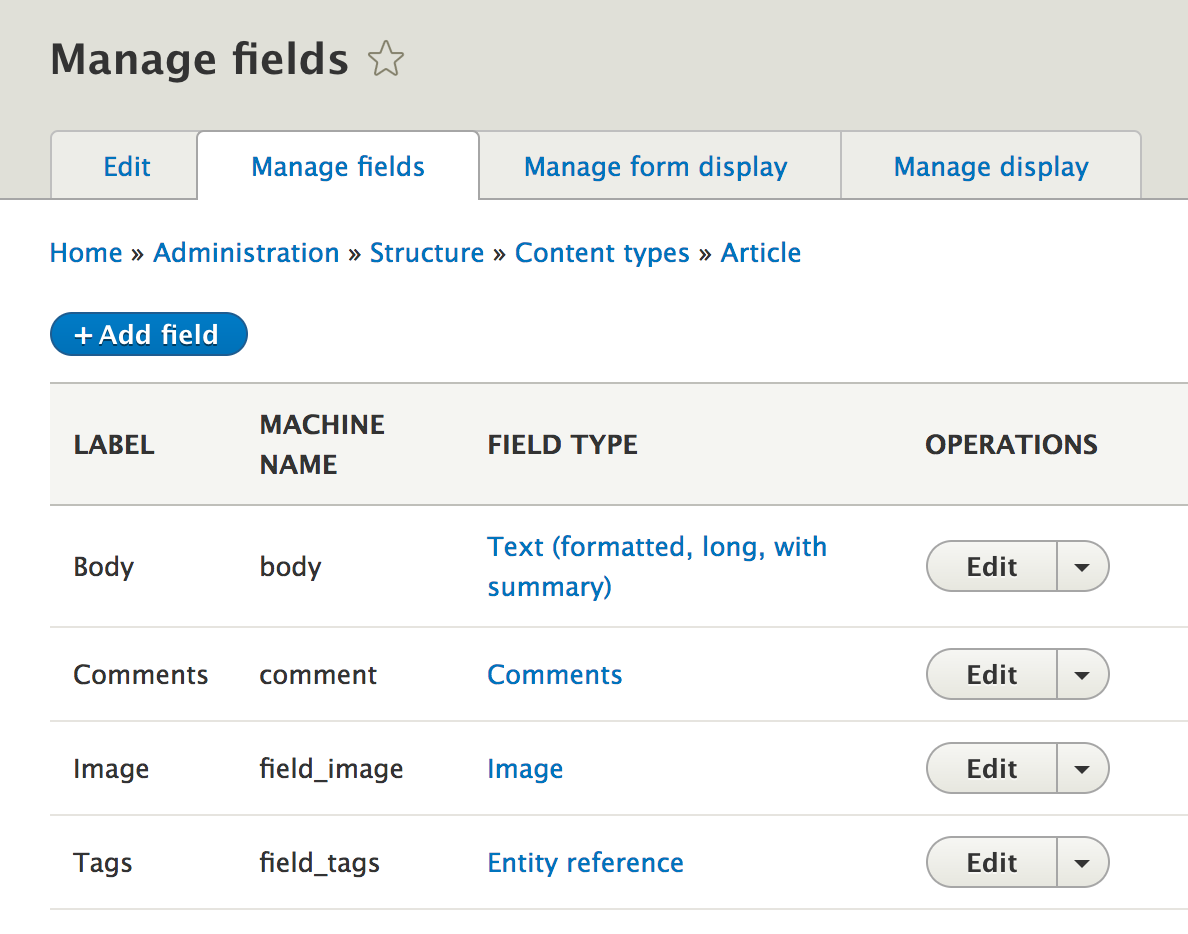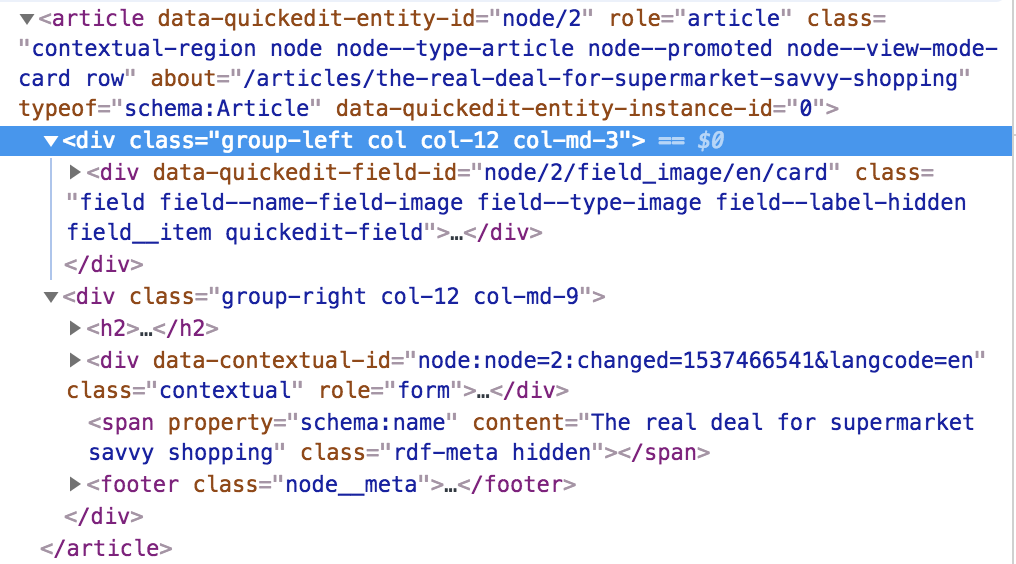Drupal 8 Theming
Week 4
Advanced Twig
Using variables in templates
{# comment #}
{{ variable }}
{% functional %}{# comment #}
{#
this is a twig comment
twig comment is not rendered in the DOM
#}{{ variable }}
{{ variable }}{% functional %}
{% set foo = bar %}In a template
{#
/**
* @file
* Theme override to display a region.
*
* Available variables:
* - content: The content for this region, typically blocks.
* - attributes: HTML attributes for the region <div>.
* - region: The name of the region variable as defined in the theme's
* .info.yml file.
*
* @see template_preprocess_region()
*/
#}
{%
set classes = [
'region',
'region-' ~ region|clean_class,
]
%}
{% if content %}
<div{{ attributes.addClass(classes) }}>
{{ content }}
</div>
{% endif %}
Example
using node.html.twig
node.html.twig
{#
/**
* @file
* Theme override to display a node.
*
* Available variables:
* - node: The node entity with limited access to object properties and methods.
* Only method names starting with "get", "has", or "is" and a few common
* methods such as "id", "label", and "bundle" are available. For example:
* - node.getCreatedTime() will return the node creation timestamp.
* - node.hasField('field_example') returns TRUE if the node bundle includes
* field_example. (This does not indicate the presence of a value in this
* field.)
* - node.isPublished() will return whether the node is published or not.
* Calling other methods, such as node.delete(), will result in an exception.
* See \Drupal\node\Entity\Node for a full list of public properties and
* methods for the node object.
* - label: The title of the node.
* - content: All node items. Use {{ content }} to print them all,
* or print a subset such as {{ content.field_example }}. Use
* {{ content|without('field_example') }} to temporarily suppress the printing
* of a given child element.
* - author_picture: The node author user entity, rendered using the "compact"
* view mode.
* - metadata: Metadata for this node.
* - date: Themed creation date field.
* - author_name: Themed author name field.
* - url: Direct URL of the current node.
* - display_submitted: Whether submission information should be displayed.
* - attributes: HTML attributes for the containing element.
* The attributes.class element may contain one or more of the following
* classes:
* - node: The current template type (also known as a "theming hook").
* - node--type-[type]: The current node type. For example, if the node is an
* "Article" it would result in "node--type-article". Note that the machine
* name will often be in a short form of the human readable label.
* - node--view-mode-[view_mode]: The View Mode of the node; for example, a
* teaser would result in: "node--view-mode-teaser", and
* full: "node--view-mode-full".
* The following are controlled through the node publishing options.
* - node--promoted: Appears on nodes promoted to the front page.
* - node--sticky: Appears on nodes ordered above other non-sticky nodes in
* teaser listings.
* - node--unpublished: Appears on unpublished nodes visible only to site
* admins.
* - title_attributes: Same as attributes, except applied to the main title
* tag that appears in the template.
* - content_attributes: Same as attributes, except applied to the main
* content tag that appears in the template.
* - author_attributes: Same as attributes, except applied to the author of
* the node tag that appears in the template.
* - title_prefix: Additional output populated by modules, intended to be
* displayed in front of the main title tag that appears in the template.
* - title_suffix: Additional output populated by modules, intended to be
* displayed after the main title tag that appears in the template.
* - view_mode: View mode; for example, "teaser" or "full".
* - teaser: Flag for the teaser state. Will be true if view_mode is 'teaser'.
* - page: Flag for the full page state. Will be true if view_mode is 'full'.
* - readmore: Flag for more state. Will be true if the teaser content of the
* node cannot hold the main body content.
* - logged_in: Flag for authenticated user status. Will be true when the
* current user is a logged-in member.
* - is_admin: Flag for admin user status. Will be true when the current user
* is an administrator.
*
* @see template_preprocess_node()
*
* @todo Remove the id attribute (or make it a class), because if that gets
* rendered twice on a page this is invalid CSS for example: two lists
* in different view modes.
*/
#}
{%
set classes = [
'node',
'node--type-' ~ node.bundle|clean_class,
node.isPromoted() ? 'node--promoted',
node.isSticky() ? 'node--sticky',
not node.isPublished() ? 'node--unpublished',
view_mode ? 'node--view-mode-' ~ view_mode|clean_class,
]
%}
{{ attach_library('classy/node') }}
<article{{ attributes.addClass(classes) }}>
{{ title_prefix }}
{% if not page %}
<h2{{ title_attributes }}>
<a href="{{ url }}" rel="bookmark">{{ label }}</a>
</h2>
{% endif %}
{{ title_suffix }}
{% if display_submitted %}
<footer class="node__meta">
{{ author_picture }}
<div{{ author_attributes.addClass('node__submitted') }}>
{% trans %}Submitted by {{ author_name }} on {{ date }}{% endtrans %}
{{ metadata }}
</div>
</footer>
{% endif %}
<div{{ content_attributes.addClass('node__content') }}>
{{ content }}
</div>
</article>
Comment block: READ
{#
/**
* @file
* Theme override to display a node.
*
* Available variables:
* - node: The node entity with limited access to object properties and methods.
* Only method names starting with "get", "has", or "is" and a few common
* methods such as "id", "label", and "bundle" are available. For example:
* - node.getCreatedTime() will return the node creation timestamp.
* - node.hasField('field_example') returns TRUE if the node bundle includes
* field_example. (This does not indicate the presence of a value in this
* field.)
* - node.isPublished() will return whether the node is published or not.
* Calling other methods, such as node.delete(), will result in an exception.
* See \Drupal\node\Entity\Node for a full list of public properties and
* methods for the node object.
* - label: The title of the node.
* - content: All node items. Use {{ content }} to print them all,
* or print a subset such as {{ content.field_example }}. Use
* {{ content|without('field_example') }} to temporarily suppress the printing
* of a given child element.
* - author_picture: The node author user entity, rendered using the "compact"
* view mode.
* - metadata: Metadata for this node.
* - date: Themed creation date field.
* - author_name: Themed author name field.
* - url: Direct URL of the current node.
* - display_submitted: Whether submission information should be displayed.
* - attributes: HTML attributes for the containing element.
* The attributes.class element may contain one or more of the following
* classes:
* - node: The current template type (also known as a "theming hook").
* - node--type-[type]: The current node type. For example, if the node is an
* "Article" it would result in "node--type-article". Note that the machine
* name will often be in a short form of the human readable label.
* - node--view-mode-[view_mode]: The View Mode of the node; for example, a
* teaser would result in: "node--view-mode-teaser", and
* full: "node--view-mode-full".
* The following are controlled through the node publishing options.
* - node--promoted: Appears on nodes promoted to the front page.
* - node--sticky: Appears on nodes ordered above other non-sticky nodes in
* teaser listings.
* - node--unpublished: Appears on unpublished nodes visible only to site
* admins.
* - title_attributes: Same as attributes, except applied to the main title
* tag that appears in the template.
* - content_attributes: Same as attributes, except applied to the main
* content tag that appears in the template.
* - author_attributes: Same as attributes, except applied to the author of
* the node tag that appears in the template.
* - title_prefix: Additional output populated by modules, intended to be
* displayed in front of the main title tag that appears in the template.
* - title_suffix: Additional output populated by modules, intended to be
* displayed after the main title tag that appears in the template.
* - view_mode: View mode; for example, "teaser" or "full".
* - teaser: Flag for the teaser state. Will be true if view_mode is 'teaser'.
* - page: Flag for the full page state. Will be true if view_mode is 'full'.
* - readmore: Flag for more state. Will be true if the teaser content of the
* node cannot hold the main body content.
* - logged_in: Flag for authenticated user status. Will be true when the
* current user is a logged-in member.
* - is_admin: Flag for admin user status. Will be true when the current user
* is an administrator.
*
* @see template_preprocess_node()
*
* @todo Remove the id attribute (or make it a class), because if that gets
* rendered twice on a page this is invalid CSS for example: two lists
* in different view modes.
*/
#}Set variables
{%
set classes = [
'node',
'node--type-' ~ node.bundle|clean_class,
node.isPromoted() ? 'node--promoted',
node.isSticky() ? 'node--sticky',
not node.isPublished() ? 'node--unpublished',
view_mode ? 'node--view-mode-' ~ view_mode|clean_class,
]
%}Attach libraries
{{ attach_library('classy/node') }}
Use vars, build template
<article{{ attributes.addClass(classes) }}>
{{ title_prefix }}
{% if not page %}
<h2{{ title_attributes }}>
<a href="{{ url }}" rel="bookmark">{{ label }}</a>
</h2>
{% endif %}
{{ title_suffix }}
{% if display_submitted %}
<footer class="node__meta">
{{ author_picture }}
<div{{ author_attributes.addClass('node__submitted') }}>
{% trans %}Submitted by {{ author_name }} on {{ date }}{% endtrans %}
{{ metadata }}
</div>
</footer>
{% endif %}
<div{{ content_attributes.addClass('node__content') }}>
{{ content }}
</div>
</article>Using attributes in templates
Attributes
<div {{ attributes }}>
class="foo"
data-drupal-foo
aria-hidden="true"
Addclass
{%
set classes = [
‘field-' ~ field_name|clean_class ~ '
]
%}
<div {{ attributes.addClass(classes) }}>…</div><div class=“field-tags”>…Removeclass
<div {{ attributes.removeClass('classname') }}><div class="nickelback">
CORE
MODULE
CLASSY
<div class="core">
CORE
MODULE
CLASSY
<div class="core nickelback">
$var['attributes']->addClass('nickelback')
CORE
MODULE
CLASSY
<div class="core nickelback theme">
{{ attributes.addClass('theme') }}
CORE
MODULE
CLASSY
<div class="core theme">
{{ attributes.removeClass('nickelback') }}
CORE
MODULE
CLASSY
<div class="theme">
{{ attributes.removeClass('nickelback','core') }}
<div>
<div {{ attributes.removeClass('nickelback') }}>
<div class="nickelback"><div {{
attributes
.removeClass('nickelback')
.addClass('rush')
.setAttribute('id', 'top')
}}>
<div id="top" class="rush">Attributes
More functions
.addClass()
.removeClass()
.setAttribute()
.removeAttribute()
.hasClass()
Create attributes
create_attribute()
{% set my_attribute = create_attribute() %}
{%
set my_classes = [
'kittens',
'llamas',
'puppies',
]
%}
<div{{ my_attribute.addClass(my_classes).addAttribute('id', 'myUniqueId') }}>
{{ content }}
</div>More docs
Exercise
Revisit last weeks templates and set the classes properly:
use attributes
Using filters in templates
Filters
{% filter upper %}
uppercase is awesome
{% endfilter %}{{ variable|upper }}Hardcoded text
Drupal variable
More filters
{{ var|clean_class }}
{{ var|clean_id }}
{{ var|format_date }}
{{ var|raw }}
{{ var|render }}
{{ var|safe_join }}
{{ var|without }}Drupal only filters
<a
href="{{ url('<front>') }}"
title="{{ 'Home'|t }}"
rel="home"
class="site-logo"
></a>Translation
{% trans %}Translatable text{% endtrans %}
Drupal only filters
Placeholder
{% trans %}
Submitted on {{ date|placeholder }}
{% endtrans %}
Without filter
{{ content|without('field') }}Without filter example
{{ content }}
{{ text }}
{{ tags }}
{{ image }}
{{ content|without('image') }}
{{ content|without('image') }}
{{ text }}
{{ tags }}
{{ content.image }}
{{ content|without('image', 'tags') }}
{{ content|without('image', 'tags') }}
{{ text }}
{{ content.tags }}
{{ content.image }}
{{ content.new }}
{{ content|without('image', 'tags') }}
{{ text }}
{{ content.tags }}
{{ content.image }}
{{ new }}
In code

In code

Finding field names

Filter docs
Exercise
Create a template for Article Card view-mode
Create wrappers for the image & other content
Context
- Go to the /articles page
- Inspect the view: notice the views-row structure
-
Each views-row contains a node--type-article
-
-
Create a template that targets only this view-mode: card
-
Change the structure: move the image to a new wrapper

Result:

Result:

Exercise
Print an image as a background-image
Context
We want our teaser image to be shown as a background-image.
Try and debug the image field and print the image-url as inline style:
Pro tip: Use kint() debugging!
<article{{ attributes.addClass(classes) }} style="background: url('{{ image_url }}');"><article class="node" style="background: url('/sites/default/files/image.jpg');">
Lets get to it!
Drupal 8 Theming IMD W4
By Pieter Mathys
Drupal 8 Theming IMD W4
Les week 4 D8IMD Theming
- 454



